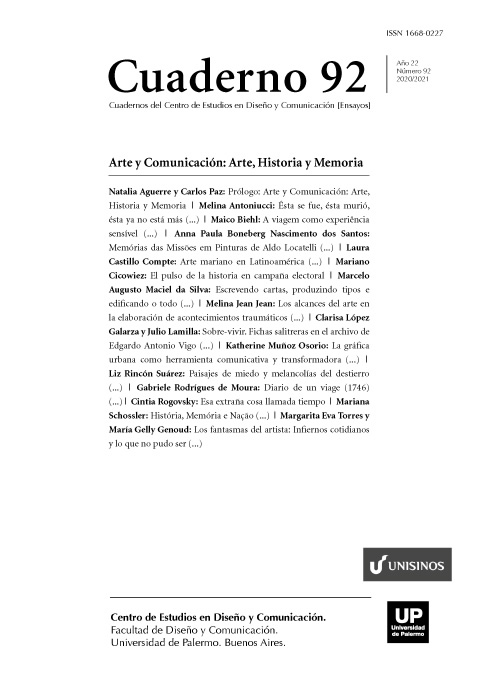Sobre-vivir. Fichas salitreras en el archivo de Edgardo Antonio Vigo. Redes de arte correo e intercambios trasandinos: algunas notas sobre la relación entre Eduardo Antonio Vigo y Eduardo Díaz Espinoza
Abstract
From the work of collection of data and classification of letters belonging to the archives of the Argentinean artist Edgardo Antonio Vigo, this article proposes to reconstitute a dimension of the dialog initiated with the poet and editor born in Antofagasta Eduardo Díaz Espinoza. This epistolary exchange was one of the most profuse between E. A. Vigo and Chilean artists –it is the second in density, after that held with the poet Guillermo Deisler–, during a period that crosses the bloodiest years of the Argentine and Chilean dictatorships. The text aims to examine how mail art activated various communication strategies and international solidarity networks, which subverted silencing in contexts of social suffocation, censorship and repression, while at the same time building spaces of exchange and emotional support among its members. In this sense, it raises how both artists, traversed biographically and familiarly by acts of torture, detention and enforced disappearance, achieved the implementation of a mutual postal support, which narrated, situationally and with a minimum latency, the events of the present. Through a review of calls and actions gestated in collaboration, we will address the study of the specificities of art and political networks spread on both sides of the Andes.
References
Alonso González Alarcón, J. (2016). La relegación: el poder ejercido por la dictadura militar como mecanismo de control social. III Jornadas de Trabajo sobre Exilios Políticos del Cono Sur en el siglo XX,9 al 11 de noviembre de 2016, Santiago de Chile, Chile. Agendas, problemas y perspectivas conceptuales. En Memoria Académica. Disponible en: http://www.memoria.fahce.unlp.edu.ar/trab_eventos/ev.9317/ev.9317.pdf
Bernal, M. C. (2015), Redes intelectuales: arte y política en América Latina. Bogotá: Uniandes.
Bugnone, A. (2016). Vigo. Arte Política y Vanguardia, La Plata: Malisia. Caraballo, J. y Padín, C. (1991). Solidaridad, Montevideo: Ed. de los autores.
Díaz Espinoza, E. (1988) Anteproyecto de proyecto de análisis poético matemático...de una tortuga, de un cangrejo, de un sapo, incluido dentro de la obra homónima de E. A. Vigo.
Dourron, S. y Ferreiro, J. (2016). Edgardo Antonio Vigo. Usina permanente del caos creativo. Obras 1953-1997. Catálogo del Museo de Arte Moderno de Buenos Aires. “Homenaje tardío Antofagasta Chile”, en Biopsia 1988/9, pp. 291-307, archivo personal Edgardo Antonio Vigo, Centro de Arte Experimental Vigo. Disponible en https://www.dropbox.com/s/qrss8bjdigizhfy/CAJA%2028%20-%201988-1989web.pdf
Kay, Ronald. (2012). Vostell, Santiago: Editor Ronald Kay. Gutierrez Marx, Graciela. (2010). Arte Correo; Artistas Invisibles en la red postal, La Plata: Luna verde ediciones.
Held, John, (2015). Small Scale Subversion: Mail Art & Artistamps, USA: TAM-Publications. Papelglifo (s/f), Antofagasta: Ediciones Guerra 33.“Por la vida de un artista”, Participación 6, Montevideo, 1984.
Restrepo, Tulio. (2009). Entrevista sobre Arte correo. Contexto Latinoamérica. Disponible en: http://clementepadin.blogspot.com/2009/02/entrevista-sobre-arte-correo-contexto.html Solicitada de Asociación Uruguaya de Arte Correo en Participación 7, Boletín de la Asociación Uruguaya de Artistas Correo, Montevideo, 1985 Solidarte/México, Desaparecidos políticos de nuestra América. I Bienal de La Habana, Ciudad de México, 1984 Vigo, E. A. (s/f), Historia del Museo de la Xilografía, La Plata: Centro de Arte Experimental Vigo.
Los autores/as que publiquen en esta revista ceden los derechos de autor y de publicación a "Cuadernos del Centro de Estudios de Diseño y Comunicación", Aceptando el registro de su trabajo bajo una licencia de atribución de Creative Commons, que permite a terceros utilizar lo publicado siempre que de el crédito pertinente a los autores y a esta revista.


